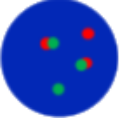Product Cat. No.: GBS-099
For Research Use Only.
JAZF1/SUZ12 gene fusion probe reagent
10 Tests/box
The kit uses orange fluorescein to label SUZ12 orange probe and uses green fluorescein to label JAZF1 full length green probe. JAZF1/SUZ12 probe can be combined with the target detection site by in situ hybridization.
The kit consists of JAZF1/SUZ12 dual color probe, as shown in Table 1.
| Component name | Specifications | Quantity | Main components |
|---|---|---|---|
| JAZF1/SUZ12 dual color probe | 100μL/Tube | 1 | SUZ12 orange probe ; JAZF1 full length green probe |


Keep sealed away from light at -20oC±5oC. The product is valid for 12 months. Avoid unnecessary repeated freezing and thawing that should not exceed 10 times. After opening, within 24 hours for short-term preservation, keep sealed at 2~8oC in dark. For long-term preservation after opening, keep the lid sealed at -20oC±5oC away from light. The kit was transported below 0°C.
Fluorescence microscope imaging system, including fluorescence microscope and filter set suitable for DAPI (367/452), green (495/517) and orange (547/565).
1. Applicable specimen type: paraffin embedded specimen of surgical resection or biopsy tissue.
2. The tissue in vitro should be fixed with 4% neutral formaldehyde fixative within 1 hour. After the tissue isfixed, it is often dehydrated and embedded in paraffin.
1. Hybridization pretreatment
Baking: Slides heating at 80oC for 30min or 65oC for 2h or overnight.
Dewaxing: According to the customer laboratory protocol (Commonly with Xylene for 15min).
Hydration: Take out the slides and put them respectively into 100%, 85% and 70% EtOH at room temperature for 3 minutes each.
Take out the slides, and immerse them in deionized water for 3 minutes. Remove the excess of water on the slides by air-drying.
Permeation: Immerse the slides in deionized water at 100oC and boil continuously for 20-40 minutes (Conventional 20min). Remove the excess of water on the slides by air-drying.
Digestion: Protease enzymic digestion at 37°C for 10-40 minutes. Mix the protease work buffer (50mmol HCl) and the 10x protease solution (Pepsin concentration 5%) in a proportion of 9:1 to prepare the enzymatic digestion solution.
Washing: Wash with 2xSSC at room temperature for 5 minutes.
Dehydration: Take out the slides and dehydrate in 70%, 85%, and 100% gradient ethanol at room temperature for 2 minutes each time.Remove the excess of EtOH solution on the slides by air-drying.
2. Denaturing hybridization
The following operations should be carried out in the dark room.
3. Washing
The following operations should be carried out in a dark room.
4. Counterstaining
The following operations should be performed in a darkroom
10μl DAPI compound dye is dropped in the hybridization area of the glass slide and immediately covered. The suitable filter is selected for glass slide observation under the fluorescence microscope.
5. FISH results observation
Place the stained sections under a fluorescence microscope and the cells area is first confirmed under a low magnification objective (10x);under magnification objective (40x) a uniform cells distribution is observed; then the nucleus size uniformity, nuclear boundary integrity,DAPI staining uniformity, no nuclei overlapping, cells clear signal are observed in the high magnification objective (100x).

Negative: 2 orange 2 green

Positive: 1 orange 1 green 1 fusion
1. Please read this manual carefully before testing. The testing personnel shall receive professional technical training, and the signal counting personnel must be able to observe and distinguish orange and green signals.
2. When testing clinical samples, when the hybridization signal counting is difficult and the sample is not enough to repeat the retest, or the cell volume is not enough for analysis, the test will not provide the test results.
3. DAPI counterstaining agent used in this experiment has potential toxicity or carcinogenicity, so it is necessary to operate in the fume hood,wear masks and gloves to avoid direct contact.
4. All chemicals are potentially dangerous. Avoid direct contact. Used kits are clinical waste and should be properly disposed off.
V1. 0: Approval date: April 22, 2021.
V1. 3: Revision date: September 21, 2022.
